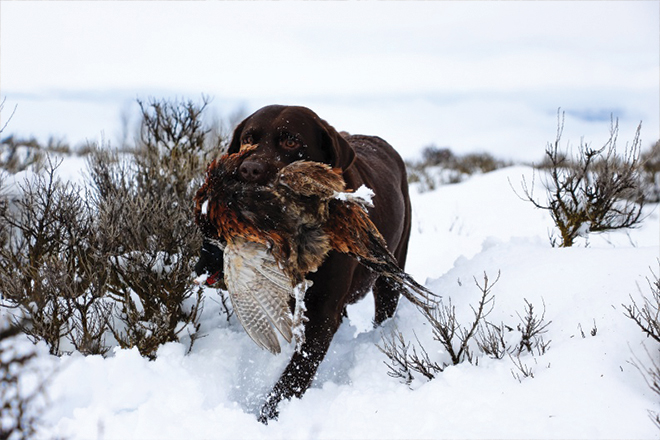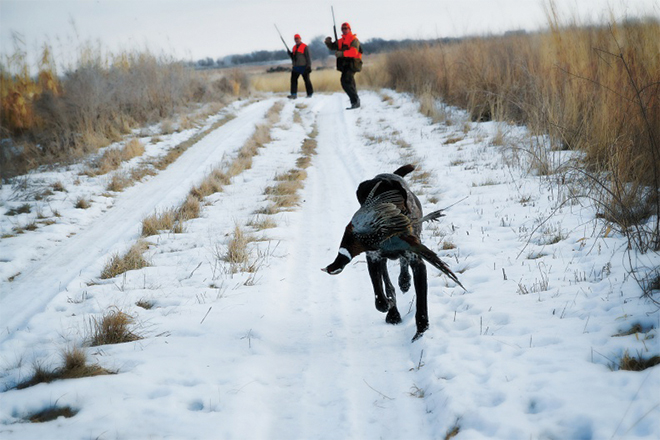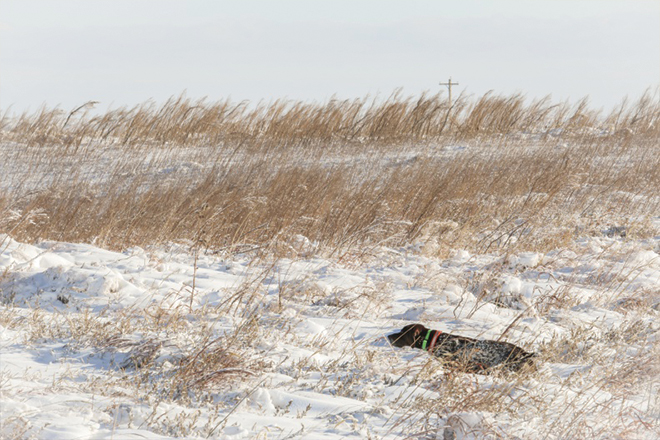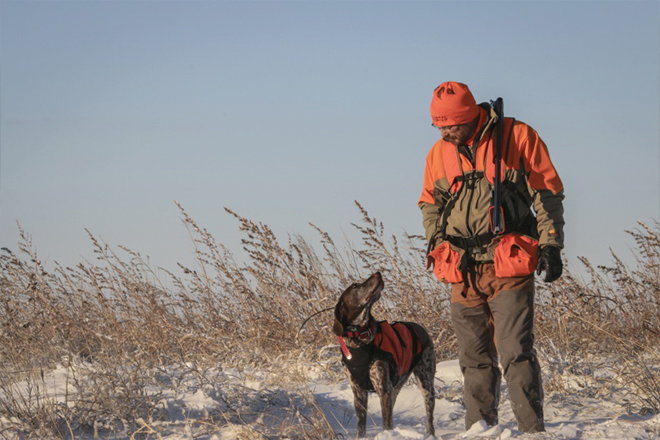How do you keep your dog healthy, happy and working hard even under harsh wintry conditions? Two experts explain all, tell how.
By Christine Cunnningham
When someone mentions caring for a dog on bad-weather winter hunts, the image that comes to mind is of Winchester, our black-and-white English setter, humping through chest-deep snow with 10 pounds of ice attached to his feathers like lead weights. Snow, weather, and avalanches are my main concerns in planning ptarmigan hunts with the dogs throughout the winter in Alaska where I live, and we tailor our hunting trips to how the dogs fare in these conditions.
Pheasant and quail dogs face challenges too (and so does Winchester on our rooster jaunts to North Dakota) … and nutrition is another area of concern for birds in winter everywhere, so I spoke to two leading experts on the subject.
Dr. Dustin Babler is a veterinarian and avid bird hunter who practices at the Animal Hospital of Woodstock in Illinois. Karl Gunzer, Director of Purina’s Sporting Dog Program, has more than 30 years’ experience working with dogs and the people who love them. Here are these two experts’ latest thoughts on bird dog nutrition when conditions are cold and your dog is hunting hard.
 Photo: Katie Daniels
Photo: Katie Daniels
A Balanced Diet Beats Supplements
According to Dr. Dustin, as far as paw pad and foot health – my two greatest concerns – a balanced diet is important, and there is not a lot to add in the way of supplements to make a dog’s feet stronger. For hunts in snow and ice conditions, he recommends keeping the toenails short to avoid injuries, trimming around the feet flush with the paw pads, and applying a barrier wax, such as Musher’s Secret, several times throughout the hunt to prevent snowballing and abrasion.
Karl agrees that if a dog is on a good quality dog food, the need for supplementation is reduced. “Dogs run best on a high fat and high protein diet,” he says. He recommends 30 percent protein and 20 percent fat. “One of the important things to know is that dogs need to be on a diet 8 to 12 weeks before they are optimally using it.” The dog should start two months before the season so its system is metabolically primed to use that food. If the dog is working hard, it’s okay to add some additional fat, but this shouldn’t be done to excess.
Off-Season Conditioning Counts
Dr. Dustin also emphasizes the value of nutrition in the offseason. “Nutrition changes don’t happen in a few days or weeks,” he says. When talking about going into the extreme, that’s when off-season training and a high protein high-fat diet pay off. “These two things are proven to help dogs metabolize,” he continues. “When dogs get in trouble with hypothermia or hypoglycemia, it’s often because these dogs are not conditioned in the off-season.”

“Off-season conditioning builds up the dogs’ ability to transport oxygen and helps them use energy more efficiently when they’re out running 10-20 miles day,” Babler adds.
Fasted Hunting and Blood Glucose Boosts
The age-old advice not to feed dogs the morning of the hunt doesn’t change for cold weather.
Dr. Dustin does not feed his dogs directly before the hunt. “They’re not going to absorb nutrients as well. After you feed, less blood goes to the body and muscles, and more is diverted to the gut.” He adds that food stays in the stomach 23-25 hours: “You want to space out feeding and maximize the interval.”
Babler recommends not feeding a dog directly after the hunt either, but rather wait to feed after the dog calms down and stops panting.

One other thing you can do to keep energy levels up is to give maltodextrin treats directly before, or 20 to 30 minutes after, the hunt. This resupplies glycogen – the first energy stored in the dog’s muscles. “Dogs that are not conditioned will burn through that glycogen a lot faster than dogs that are conditioned,” says Dr. Dustin.
Karl carries and recommends a couple of packets of honey in a kit to use if a dog becomes hypoglycemic. Dr. Dustin does not recommend these as routine supplements as excess use can cause diarrhea and actually cause rebound drops in blood glucose.
If people feel a need to feed their dog in the morning, Gunzer suggests a minimum of two hours between feeding the dog and working the dog: “Ideally though you would feed the night before, give the night to digest, and the dog would be done with digestion the next morning.”
Identifying Hypoglycemia and Hypothermia
The two most common cold-weather problems for dogs are hypoglycemia (low blood sugar) and hypothermia (reduced body temperature).
One way to determine if the dog’s overall behavior indicates hypothermia or hypoglycemia is a rectal thermometer. Any temperature below 99.5 for a working dog is a sign of hypothermia. Other things to look for are a dog slowing down, a clumsy or “drunken” gait, shivering or running away or abnormal behavior. In severe situations, the dog can collapse.
Dr. Dustin recommends bringing a towel to dry the dog off, and a Mylar emergency blanket. “Snow evaporating off will continue to take body heat,” he says, and he does not recommend using hot water or heating pads, as the dog will not be able to sense if their skin is burning. Karl is cautious of using non-insulated plastic kennels. “It’s critical to have good warm bedding and a kennel where the dog is out of the wind and can retain some body heat.”
Human Hydration is Different than Dog Hydration
Hydration is critical in cold weather. A well-hydrated dog is less susceptible to hypothermia and frostbite.
Karl, who is most often concerned about warm-weather conditions, observes that people often forget about the importance of hydration in cold weather. “In many cases, dogs get more dehydrated in cold weather situations, and dogs aren’t as inclined to drink. When it gets cold, it’s also extremely dry. He suggests feeding “wet” or floating the kibble like you might put milk in your cereal. This helps ensure the dog is consuming amount of water with their food.
Another way to encourage drinking is to bait the water. Karl will use a small amount of low sodium chicken broth or bullion. “People lose salts when they sweat, but dogs do not, and increasing their salt load causes further dehydration.” So don’t overdo the broth or boullion.
Dogs will generally drink the most 1-2 hours after a meal, so Karl stresses the importance that the dog has access to water at this time. He also uses a product called FortiFlora, a probiotic that helps improve gut digestion.

Dr. Dustin takes a water bottle for his dog. If the dog is not in an emergency state, he will squirt the water bottle into the dog’s mouth. If a dog is in a dehydrated or hypoglycemic state, he will not force water. Like Karl, he will sometimes bait water with low sodium beef broth, noting the common misconception about giving dogs electrolytes: “We often put on dogs what’s right for humans. Dogs don’t sweat and are very efficient at monitoring electrolytes. If you give a dog electrolytes, they will expel water.” That’s bad.
Conclusion
Perhaps some of the best all-weather advice I’ve heard about dog care is this:
“Know normal to spot abnormal.” Karl Gunzer reiterates this and adds, “You need to be your dog’s advocate and pay attention. If something doesn’t seem right, it probably isn’t. Ultimately, the dog will give itself to the hunt, and each of us is responsible for the dog. You’re the coach, and you tell them when to give a second effort and when to hit the showers.”